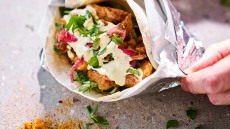The ‘world’s first’ alt seafood association wants to close the protein, omega gap

The ‘world’s first’ alternative seafood association, Future Ocean Foods, is launching today. Representing makers of plant-based, fermentation-enabled, and cultivated seafood alternatives, the association wants to support and accelerate the alternative seafood industry worldwide.
A total of 35 members from 14 countries have joined the association, including companies Aqua Cultured Foods, Bettaf!sh, Hooked Foods, and Sophie’s BioNutrients, amongst others. Partners include alternative protein advocates the Good Food Institute (GFI) and ProVeg International, as well as the Global Organization for EPA & DHA Omega-3s (GOED).
A number of activities are on the association’s to-do list, from fostering knowledge-sharing and collaboration to spearheading global events for alt seafood stakeholders.
Focus on health and nutrition is also on the agenda: the association wants to increase awareness of the health benefits of alternative seafood, while simultaneously raising the nutritional profile of the category, with particular emphasis on protein and omegas.
Plant-based seafood alternatives don’t always hit the mark on protein and omega content, explained Marissa Bronfman, founder and executive director of Future Ocean Foods. “They still don’t necessarily have the nutritional profile that many consumers expect from, let’s say, a wild caught salmon.”
Boosting protein and omegas in plant-based seafood
To date, the alternative protein space has largely focused on developing chicken, pork, and beef-like products. Alternative seafood is a relatively nascent category, but with big potential. The global traditional seafood industry is projected to surpass $700bn (€655bn) by 2030.
Investment in alternative seafood start-ups has increased in recent years, up 92% from 2021 to 2022. In the US, retail sales grew 42% over a similar period.
Despite the obvious market potential, encouraging the switch from conventional seafood to plant-based, fermented-enabled, or cultivated alternatives is reliant on consumer acceptance. A key purchase driver – particularly for plant-based products – is health nutrition.
Across all categories of alternative seafood, whether made from fungi, yeast, animal cells or plants, products are ‘healthy, nutritious, and clean label’, Bronfman, an advisor to food tech founders and investors, told FoodNavigator. But undeniably, the most commercialised category is plant-based.
“Typically, a plant-based alternative seafood product is clean label,” she told us, citing examples of alt seafood products made from carrots or other vegetables. Aubergines and tomatoes are other examples of well-known ingredients used to mimic seafood.
While there are obvious benefits to using nutritious, clean label ingredients, the products often don’t boast the same nutritional profile as their conventional counterparts. Gaps exist between the protein and omega contents found in fish and other seafoods, and plant-based alternatives, we were told. Future Ocean Foods wants to change that.
“As an association, we consider nearly all alternative seafood options to be incredible healthy – certainly those created by our members. But in some instances, there is still a gap to increase protein and increase omegas so that consumers who are used to getting [those nutrients] from traditional seafood can come to expect that from alternatives,” said Bronfman.
Spotlight on human and planetary health
The association founder is ‘very’ supportive of seafood alternatives boasting a similar nutritional profile to the real thing. But even if some products are currently lagging in protein and omega content, the association is convinced they still offer a healthier option. One of its ambitions is to increase education and awareness of the health and environmental benefits of alternative seafood.
Health concerns associated with conventional seafood production and consumption include their sometimes elevated concentrations of mercury and microplastics. The association founder is also concerned about the presence of diseases and antibiotics in seafood.
From an environmental perspective, too, alternatives come out on top, according to the association, which stresses that global fisheries are expected to collapse by 2048 due to human-led destruction and climate change. “Ocean warming and acidification, algae blooms, coral bleaching, mercury levels and the omnipresence of microplastics, as well as enormous problems with antibiotics, disease, animal welfare and bycatch, are causing extreme and rapid loss of biodiversity and marine life, and threatening international food supplies.
“The global seafood industry is projected to surpass $700bn by 2030, however wild catch and aquaculture simply cannot – and should not – fulfil this demand. As we prepare for a future population of 10bn people by 2050, the need for creating and scaling sustainable protein sources has never been more urgent.”
So even if an alternative does not yet have an equivalent protein or omega content, Bronfman says it remains ‘hugely’ beneficial for human and planetary health. “We are thrilled to see alternatives, irrespective of protein or omega content, gain market share. But in parallel, we are also committed to working to increase that as an industry.”
Reeling in seafood giants
Another objective on the new association’s agenda is to initiate collaboration with traditional seafood companies and organisations to help diversify their offerings. As it stands, Future Ocean Foods’ list of members does not include any of the world’s largest seafood companies, be it Maruha Nichiro, Thai Union, or Mowi, even though some seafood majors have developed plant-based lines.
Indeed, its current list only features companies that have been purely focused on seafood alternatives since their inception. Going forward, this may change, Bronfman suggested.
“Many of our member companies are working with traditional seafood companies, which is hugely excited… In terms of our member base right now, you’ll find that all of our companies are creating alternative seafood products almost exclusively. But as we get bigger and broaden our activities and scope, we’ll definitely look to work with some of those legacy companies are diversifying."














